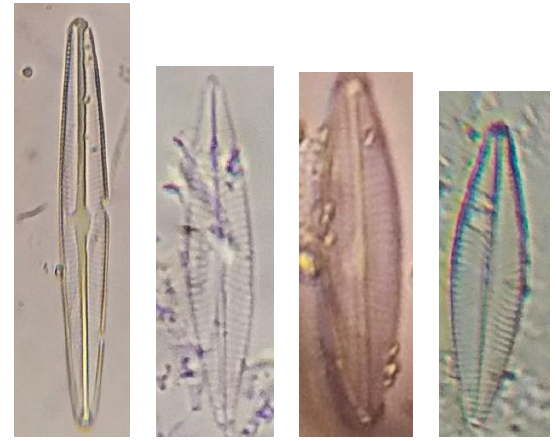Determination of Minimum Number of Frustule for Identification of Diatoms in Telaga Cebong, Dieng, Central Java, Indonesia
DOI:
https://doi.org/10.51264/inajl.v3i2.27Keywords:
Diatom, Minimum Frustule, Paleolimnology, Telaga Cebong DiengAbstract
Diatoms belong to the division of Bacillariophyta; their cell walls composition of silica (SiO2) was the primary characteristic of their structure. Diatoms are good for water quality assessment and paleolimnological analysis. The determination number of frustule which has to be counted for diatom is one of the critical steps in process identification. Several studies usually use a range starting from 100-600 frustules, which refers to the "fixed count" method, that is time-consuming. Research about the minimum frustules number that is acceptable for water character in Indonesia has been limited studied. This research aim is to determine the minimum number of frustules need to identify the diatom assemblage, especially at Telaga Cebong, Dieng, Central Java, Indonesia. The sediment samples were taken vertically with D’Section corer until a depth of 200 cm sediment samples then sliced every 10 cm. The labwork activites consisted of digestion, preparation, enumeration, and identification of diatom species with the numberof frustules of 100,200, 300, 400, 500, and 600. The diatom data are analyzed with the formula for the maximum efficiency value. Based on 19 sediment samples from different sediment layers, the maximum efficiency value obtained was above the range of 0.85 to 0.92. The number of identified species remained stable after a minimum of 300 frustules. Therefore, at least 300 frustules are needed for identification of diatom for paleoreconstructions at Cebong Lake.
References
Bates N & Newall P. 2002. Techniques for the use of diatoms in water quality assessment: how many valves. Proceeding of 15th International Diatom Symposium. p.153-60
Battarbee RW. 1986. Diatom Analysis. Handbook of Holocene Palaeoecology and Palaeohydrology. Pages 527–570 in B. E. Berglund. Wiley & Sons Ltd., New York, NY.
Brabcova B, Petr M, Libus?e O, Karel B, Marke´ta F, & Jir??´ H. 2017. Diatoms in water quality assessment: to count or not to count them. Hydrobiologia, 795(2),113-127.
Falasco E, Ector L, Wetzel CE, Badino G, & Bona F. 2021. Looking back, looking forward: a review of the new literature on diatom teratological forms (2010-2020). Hydrobiologia, 848, 1675-1753.
Kelly M, Juggins S, Guthrie G, Pritchard S, Jamieson J, Rippey B, Hirst H, & Yallop M. 2008. Assessment of ecological status in UK rivers using diatoms. Freshwater Biology, 53, 403-422.
Leterme SC, Eloise P, Jim M, Melissa HB, Amanda VE. 2013. Diatom adaptibility to environmental change: a case study of two cocconeis species from high-salinity areas. Diatom Research, 28 (1), 29-35.
Brown M P & Austin K. 2005. The New Physique (Publisher Name, Publisher City, 2005), pp. 25–30.
Pappas JL, Stoermer EF. 1996. Quantitative method for determining a representative algae sample count. Phycology, 32, 693-696.
Peabody A J. 1977. Diatoms in Forensic Science. Journal of the Scientific Society, 17, 81-88.
Pestryakova LA, Herzschuh U, Gorodnichev R & Wetterich S. 2018. The sensitivity of diatom taxa from Yakutian lakes (north-eastern Siberia) to electrical conductivity and other environmental variables. Polar Research, 37, 1485625.
Round F E, Crawford RM, & Mann D G.1993. The Diatoms. Biology and Morphology of the Genera. Cambridge: Cambridge University Press.
Ruhland K, Alisha P, & Smol J P. 2021. Paleolimnological Evidence from Diatoms for Recent Environmental Changes in 50 Lakes across Canadian Arctic Treeline. Arctic, Antarctic, and Alpine Research, 35(1), 110-123.
Setiawan MA. 2012. Integrated Soil Erosion Risk Management In The Upper Serayu Watershed, Wonosobo District, Central Java Province, Indonesia Dissertation, Institute of Geography, University of Innsburck.
Setyowati DL, & Hardati P. 2009. Fenomena Dataran Tinggi Dieng. Yogyakarta: Grafindo Litera Media.
Soeprobowati TR, Tandjung SD, Sutikno S, Hadisusanto S, & Gell P. 2016.The Minimum Number of Valves for Diatom Identification in Rawapening Lake, Central Java. Biotropia, 23(2), 96 – 104.
Soeprobowati TR, Agung SWS, Hadiyanto, Lubis AA, & Gell P. 2018. Diatom assemblage in the 24 cm upper sediment associated with human activities in Lake Warna Dieng Plateau Indonesia. Journal Environment Technology & Innovation, 10, 314-323.
Stevenson R J. & Bahls L L. 1999. Peryphyton Protocols. In Barbour, M. T., J. Gerritsen, B. D. Snyder dan J. B. Stribling [Eds.] Rapid Bioassessment Protocols for Use in Streams and Wadeable Rivers: Periphyton, Benthic Macrounvertebrates and Fish. 2nd ed. US Environmental Protection Agency, Office of Water, Washington DC.
Sudarmadji, Heri S, & Sri L. 2015.Danau-Danau Volkanik Di Dataran Tinggi Dieng: Pemanfaatan dan Masalah Lingkungan Yang Dihadapi. Jurnal Teknosains. 5(1),36-48.

Downloads
Published
Issue
Section
License
Copyright (c) 2022 Indonesian Journal of Limnology

This work is licensed under a Creative Commons Attribution 4.0 International License.






